Puncture Vine (Tribulus terrestris)
Family – Zygophyllaceae or caltrop family
Puncture Vine is also known as Goat heads and Gokshura in Ayurvedic medicine. Most of us know them as those painful, thumbtack like stickers that puncture bicycle tires and make dogs cry. Tribulus means “terrible earth,” and you certainly won’t miss them when they’re not around. These plants are seldom sought out, and I honestly don’t know anyone who has planted them on purpose. But it is good to know that even these (and I’m going to use “the word” here,) noxious weeds have wonderful medicinal value.
The following article contains affiliate links. If there is a link, Please assume I am an affiliate. That means, if you purchase a product through one of the links, I make a commission at no additional cost to you. I appreciate it each time you click on or make a purchase from one of my links. Thank you for your support.
I love this plant medicinally and it is for that reason that I let 1 or two plants grow around the garden every year. I do not, however, let them go to seed.
About Puncture Vine
The plant, Tribulus terrestris, is common around the world. It is used in Western Herbalism, Ayurveda and Traditional Chinese Medicine to name a few. Honestly, it’s probably used by traditional cultures wherever it grows.
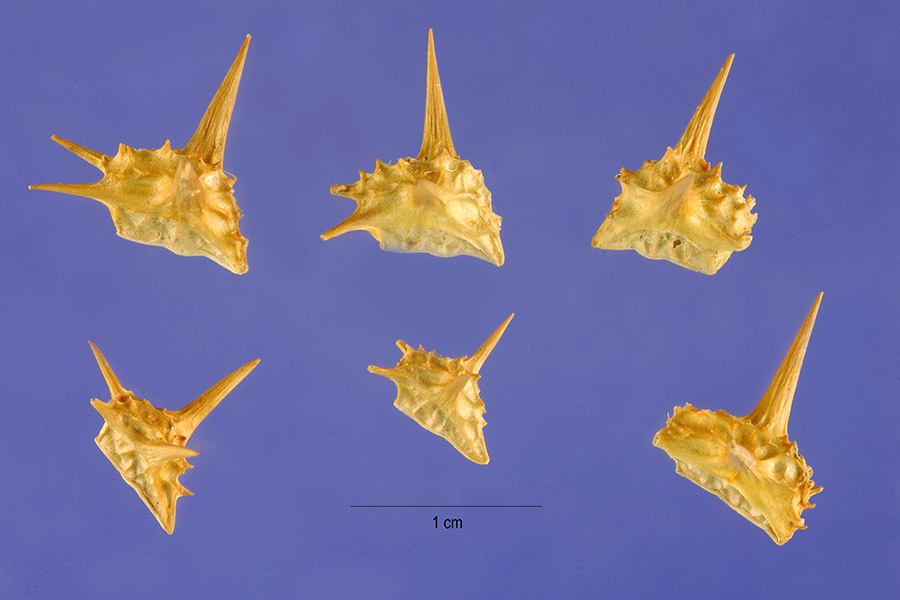
Description of Puncture Vine
A common and widely distributed annual, originally from warm temperate and tropical regions in southern Eurasia and Africa, Puncture Vine was unintentionally spread all over the word. In my experience, it likes disturbed ground and waste areas. I always run into it in the Midwest from Minnesota to Texas and from the plains of Colorado to the Mississippi. I know it grows many other places as well. This is not a picky plant; in fact, it seems to thrive where nothing else can grow. The dogs always let me know when it is around.
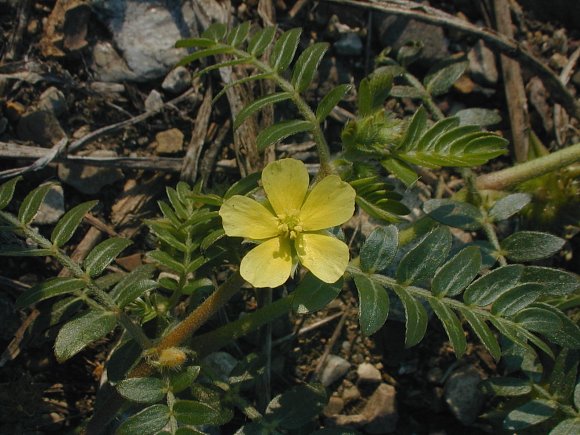
Upon sprouting, Puncture Vine develops a mat of prostrate, frequently-branching stems about 1-3′ across. The round stems are initially green but quickly become brown and are covered with dense short hairs, with some long hairs. The leaves are pinnately compound, made up of 4-8 pairs of leaflets. Each compound leaf is about 2-4″ long, with a hairy central stalk. The leaflets are dark green and up to ¾” long and ¼” across. Leaflets are oblong, smooth along the margins, and sparsely to moderately hairy. There is a short petiole at the base of each leaflet.
The flowers occur individually from the axils of the compound leaves on hairy pedicels about ½–¾” long. Each flower is about ½” across, consisting of 5 yellow petals, 5 triangular green sepals, 10 stamens with yellow anthers, and a pistil with a 5-lobed stigma. The petals are well-rounded and longer than the sepals. Flowers produce a spiny fruit that is divided into 5 segments, called a caltrop, each with several stout prickles. The seed is initially green but later dries and turns brown.
Parts Used and Harvesting
The above ground or areal part of the plant is harvested when the caltrops are green, and the plant is in flower. I like to dry some for powdering and tea and use the rest for making fresh plant tincture. If there is any left, burn it. Don’t put in the compost pile or you’re likely to have Puncture Vine everywhere.
Dry the plant by placing the whole plant mass, loosely in a paper bag or cardboard box. Shake or stir several times per day until dry. Be sure to wear your gloves because the green fruits are still nasty stickers.
Make a make fresh plant tincture by chopping the plant and stuffing as much as will fit into a mason jar and pouring 100% food-grade alcohol to cover. Place the lid on the jar, put in a dry place out of direct sun, and shake every day for at least 2 weeks.
Chemical Constituents
Tribulus contains a complicated photochemistry that includes saponins, flavonoids, glycosides, alkaloids, and tannins. Protodioscin, a saponin and glycoside, is arguably the most important constituent. According to Donald Yance, it is important for the Protodioscin content be a least 15%. He says that most commercial plant material is .17 to 6.5 %. Therefore, it’s probably best to purchase Puncture Vine from a wild-crafter or small herbal supplier that grows and harvests the plants themselves, or from commercial sources where chemical content is tested.
Medicinal Properties
Aphrodisiac, hormone modulator, adaptogen, rejuvenator, restorative, diuretic, antilithic, analgesic, genitourinary tonic, galactagogue, sedative, and nervine.
Energetics – Puncture Vine is energetically cooling, bitter and sweet.
Medicinal Use of Puncture Vine
Tribulus has a long history of medicinal use in Ayurveda, Traditional Chinese Medicine, ancient Greek medicine and more. Traditionally the plant is used as a rejuvenation tonic for the reproductive and urinary systems, as a hormonal modulator, to lower (or stabilize) blood pressure and cholesterol levels, and to help clear eyesight. It has a balancing effect on the endocrine system, is calming to the nervous system, promotes mental clarity and builds vitality.
One of the ways the plant works is to increase the level of DHEA in our body.
DHEA (Dehydroepiandrosterone)
Dehydroepiandrosterone or DHEA, is a steroidal hormone produced by the adrenal glands. The adrenal glands are triangular-shaped glands, located on top of both kidneys, that produce hormones that regulate metabolism and blood pressure. Adrenal glands produce hormones that modulate the immune system, sexual and reproductive function, harmonize blood sugar balance and more.
DHEA is produced from cholesterol and is the highest circulating steroid in the body. Interestingly, DHEA does not do much on its own, yet it is an important building block in the production of other hormones like testosterone and estrogen.
Human DHEA levels peak in early adulthood, then slowly decrease as we age. In theory, if we raise our DHEA levels, we might slow the aging process and improve physical and mental resilience. Although this has not been proven, some studies do suggest that the steroid could improve some age-related difficulties like vaginal dryness in post-menopausal women, prostate issues for men (like BPH) and improve bone and mineral density in the elderly. All these benefits, coincidently, are related to the medicinal actions of Tribulus or Puncture Vine.
Tribulus and the Reproductive System
The above ground part of the plant, especially the green caltrops or seeds, are effective as a hormonal modulator and aphrodisiac in both men and women. It is often used to increase libido, as a fertility tonic, to help modulate estrogen and testosterone levels, and heighten sexual desire. Puncture Vine increases DHT levels, which is responsible for the growth of body hair.
For men Puncture Vine helps increase the strength of erections, increases production and mobility of sperm, is used to treat premature ejaculation, and to decrease the symptoms and inflammation associated with prostate problems. The herb is often used as a remedy in the treatment of epididymitis (inflammation or infections of the testes,) and chronic prostatitis as well as a support for andropause or male menopause.
Women may find Tribulus helpful in the treatment of infertility*, PCOS* (polycystic ovarian syndrome,) amenorrhea or suppressed menstruation, to help balance endocrine function in the case of ovarian cysts and as a pelvic tonic.
*In cases of PCOS, Puncture Vine is most helpful when LH (luteinizing hormone) is low and FSH (follicle-stimulating hormone) ratio is elevated.
*When taken as a fertility tonic for women, it is best used during Follicular phase (days 4 to 14 after menstruation starts.)
Puncture Vine as a Kidney Tonic
As a kidney rejuvenator and decongestant, this herb is helpful for most urinary disorders. First and foremost, Puncture Vine strengthens and nourishes the kidneys. It promotes the flow of urine, cools, sooths and tones the urinary muscles and membranes, stops bleeding and aids in the discharge of stones. Tribulus helps relieve difficult or painful urination, including chronic cystitis and gout. It is often used as a remedy for nephritis (kidney infection), sciatica and rheumatism.
Cardiovascular tonic
Puncture Vine works well with other herbs to improve cardiovascular health and to treat hypertension or high blood pressure. In this regard, it seems to be the most useful for folks who have high cholesterol levels and is indicated as a cardiovascular tonic with the additional symptoms of headaches and dizziness.
Diabetes and Puncture Vine
One study I came across showed that Tribulus significantly reduced the level of serum glucose, serum triglyceride, and serum cholesterol, all high in those with Type 2 diabetes. The study further showed that by lowering blood glucose, lipid levels, and by its antioxidant mechanism, Puncture Vine enhanced the absorption of the drug Metformin, a common drug taken to modulate blood sugar levels. I do not have any experience with this function of Tribulus, but I find in interesting and inspiring of further study.
Regenerative and Restorative properties and uses
Puncture Vine herb helps build vitality, energy, lean muscle growth and enhances stamina. It helps promote protein synthesis, increasing recuperation time and recovery after muscular stress. For this reason, it is used by athletes with an eye on increased physical and mental performance, building muscle, burning fat, and helping relieve pain.
As a side benefit, Puncture Vine has been shown to improve your sense of well-being and help enhance mood. It also stimulates the flow of bile and helps the liver breakdown fats.
Tribulus Recipes
Aphrodisiac
One possible Aphrodisiac Recipe to increase libido and fertility. (Taken from “The Yoga of Herbs” by Dr David Frawley and Dr Vansant Lad)
- 1 teaspoon powdered Puncture Vine herb
- 8 ounces cold milk
Place on low heat and bring slowly to a boil. Remove from heat. Enjoy. Honey may be added if you like.
Fertility Tonic for Women/Elevated FSH Hormone
From Katia LeMone – Midwife and Herbalist
- Puncture Vine (Tribulus terrestris) 80ml
- Shitavari (Asparagus racemose) 10ml
- Vitex agnus-castus 5ml
- Wild Yam Root (Dioscrea villosa) 5ml
Mix individually prepared alcohol tinctures. Suggested dose is 10 ml 3 times per day.
Relief of Back Pain
From “The Yoga of Herbs”
- Mix equal amounts of Ginger and Puncture Vine. Take 60 drops tincture or put 1 teaspoon in 1 cup boiling water for about 20 minutes. Take 3x per day or as needed for back pain.
Contra-Indications
- Because of Puncture Vine’s potential to reduce blood sugar levels and increase the absorption of Metformin, those taking diabetic medicine should talk to their doctor before using this herb.
- Contra-indicated for those with a history of breast or uterine cancer.
- This is not a tonic herb. Small doses are best, large doses can irritate the kidneys and cause dizziness. It is contra-indicated in pregnancy.
- Puncture Vine should be avoided by people with significant kidney or cardiovascular disease. It should also be avoided by those with bradycardia or a slower than normal heart rate.
Thank you for reading my plant profile for Puncture Vine. I hope you found it informative and helpful. Please use the comment section below, if you are so inclined, to comment about your experiences or share questions about this plant. The more we share, the more we know.
Thank you for joining me.
Many Blessings
Annie
Suggested Products by Wonderment Gardens
Further Reading


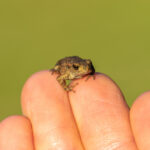
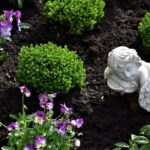
Astaxanthin and Lipothiamine – Memory Strengthening Strategies
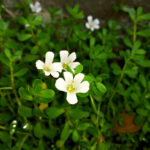
References
By Steve Hurst @ USDA-NRCS PLANTS Database – USDA-NRCS PLANTS Database, Public Domain, https://commons.wikimedia.org/w/index.php?curid=3735698
https://www.illinoiswildflowers.info/weeds/plants/puncture_vine.htm
https://www.ncbi.nlm.nih.gov/pmc/articles/PMC3931200/
https://www.adrenal.com/adrenal-gland/function
https://www.health.harvard.edu/newsletter_article/dhea-and-health-more-questions-than-answers
Stage, Katie ND, RH (AGH); Herbal Treatments for Low Libido, Southwest Conference on Botanical Medicine lecture notes, 2014.
Stage, Katie ND, RH (AGH) and McAllister Heath ND, RH (AGH); Botanicals Without Borders, Surpassing our Gender Bias with Herbs; Southwest Conference on Botanical Medicine conference notes, 2014.
Yance, Donald (AGH); Evaluating Primary Markers for Biological Age Assessment; Medicines of the Earth lecture notes, 2004.
Moore, Michael, Medicinal Plants of the Mountain West; Museum of New Mexico Press, Santa Fe NM, 2003
Frawley, David Dr, and Lad, Vasant Dr; The Yoga of herbs; Lotus Press, Twin Lakes Wi, 2001
Miller, Jason DACM, Lac; Neurological and Cognitive Decline – Integrating Traditional Solutions with the Latest Research on Brain Function; Southwest Conference on Botanical Medicine lecture notes, 2019.
Kane, Charles; Medicinal Plants of the American Southwest, Lincoln Town Press, 2011
Disclaimer
The statements and ideas presented here are not intended to diagnose, treat, cure, or prevent any disease or condition. They have not been evaluated by the FDA. All ideas presented are for the sole purpose of education. To help you take control of your own health. If you have a health concern or condition, consult a physician. We suggest that you always consult a medical doctor before modifying your diet, using any new product, drug, supplement, or doing any new exercises.
These statements and products have not been evaluated by the FDA. They are not intended to diagnose, treat, cure, or prevent any disease or condition. If you have a health concern or condition, consult a physician. Always consult a medical doctor before modifying your diet, using any new product, drug, supplement, or doing any new exercises.
Herbs taken for health purposes should be treated with the same care as medicine. Herbal remedies are no substitute for a healthy diet and lifestyle. If you are serious about good health, you’ll want to combine diet, exercise, herbals, a good relationship with your doctor and a generally healthy lifestyle. No one of these will do it alone.
This information is designed to be used as part of a complete health plan. No products are intended to replace your doctor’s care, or to supersede any of his/her advice or prescriptions.

